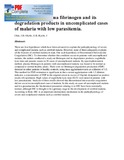Estimation of plasma fibrinogen and its degradation products in uncomplicated cases of malaria with low parasitemia.

View/
Date
1992Author
Chek, J.B
Okello, G.B
Kyobe, J
Type
ArticleLanguage
enMetadata
Show full item recordAbstract
There are four hypotheses which have been advanced to explain the pathophysiology of severe and complicated malaria such as cerebral malaria. However, none of them adequately explains all the features of cerebral malaria in man. One such hypotheses is Disseminated Intravascular Coagulation (DIC). To determine whether this condition occurs in patients with uncomplicated malaria, the authors conducted a study on fibrinogen and its degradation products, euglobulin lysis time and parasite counts in 30 cases of uncomplicated malaria. By spectrophotometric method, plasma fibrinogen in patients with uncomplicated malaria was found to be normal as compared to normal healthy adults. There were no fibrinogen degradation production (FDP) detected in either patients or healthy controls, using latex agglutination tests at a dilution of 1:5. This method for FDP estimation is significant in that a serum agglutination with 1:5 dilution indicates a concentration of FDP in the original serum in excess of 10g/ml, designated as positive results of experiment. High values of euglobulin lysis time (ELT) were noted in patients with low parasitaemia. Analysis of these results showed that disseminated intravascular coagulation did not occur in uncomplicated cases of malaria. In this study on cases of uncomplicated malaria and low parasitaemia the biochemical parameters relating to to DIC have been essentially normal, although DIC is thought to be a primary stage in the development of cerebral malaria. According to Reid, DIC is an important intermediate mechanism in the pathophysiology of severe and complicated malaria such as cerebral malaria.
URI
http://hinari-gw.who.int/whalecomwww.ncbi.nlm.nih.gov/whalecom0/pubmed/1473515http://erepository.uonbi.ac.ke:8080/xmlui/handle/123456789/17323
Citation
East Afr Med J. 1992 Oct;69(10):583-6.Publisher
Department of Biochemistry, University of Nairobi.
Collections
- Faculty of Health Sciences (FHS) [10415]
- Journal Articles [329]
